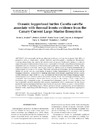Please use this identifier to cite or link to this item:
https://accedacris.ulpgc.es/handle/10553/72187
| DC Field | Value | Language |
|---|---|---|
| dc.contributor.author | Scales, Kylie L. | en_US |
| dc.contributor.author | Miller, Peter I. | en_US |
| dc.contributor.author | Varo-Cruz, Nuria | en_US |
| dc.contributor.author | Hodgson, David. J. | en_US |
| dc.contributor.author | Hawkes, Lucy A. | en_US |
| dc.contributor.author | Godley, Brendan J. | en_US |
| dc.date.accessioned | 2020-05-08T07:18:45Z | - |
| dc.date.available | 2020-05-08T07:18:45Z | - |
| dc.date.issued | 2015 | en_US |
| dc.identifier.issn | 0171-8630 | en_US |
| dc.identifier.other | WoS | - |
| dc.identifier.uri | https://accedacris.ulpgc.es/handle/10553/72187 | - |
| dc.description.abstract | Oceanographic fronts are physical interfaces between water masses that differ in properties such as temperature, salinity, turbidity and chlorophyll a enrichment. Bio-physical coupling along fronts can lead to the development of pelagic biodiversity hotspots. A diverse range of marine vertebrates have been shown to associate with fronts, using them as foraging and migration habitats. Elucidation of the ecological significance of fronts generates a better understanding of marine ecosystem functioning, conferring opportunities to improve management of anthropogenic activities in the oceans. This study presents novel insights into the oceanographic drivers of habitat use in a population of marine turtles characterised by an oceanic-neritic foraging dichotomy. Using satellite tracking data from adult female loggerhead turtles Caretta caretta nesting at Cape Verde (n = 12), we tested the hypothesis that oceanic-foraging loggerheads associate with mesocale (10s to 100s of km) thermal fronts. We used high-resolution (1 km) composite front mapping to characterise frontal activity in the Canary Current Large Marine Ecosystem over 2 temporal scales: (1) seasonal front frequency and (2) 7 d front metrics. Our use-availability analysis indicated that oceanic loggerheads show a preference for the highly productive upwelling region between Cape Verde and mainland Africa, an area of intense frontal activity. Within the upwelling region, turtles appear to forage epipelagically around mesoscale thermal fronts, exploiting profitable foraging opportunities resulting from physical aggregation of prey. | en_US |
| dc.language | eng | en_US |
| dc.relation.ispartof | Marine Ecology - Progress Series | en_US |
| dc.source | Marine Ecology Progress Series [ISSN 0171-8630], v. 519, p. 195-207, (Enero 2015) | en_US |
| dc.subject | 251005 Zoología marina | en_US |
| dc.subject.other | Central North Pacific | en_US |
| dc.subject.other | Longline Fishing Grounds | en_US |
| dc.subject.other | Olivacea Sea-Turtles | en_US |
| dc.subject.other | Satellite Tracking | en_US |
| dc.subject.other | Phytoplankton Blooms | en_US |
| dc.subject.other | Upwelling Filament | en_US |
| dc.subject.other | Foraging Ecology | en_US |
| dc.subject.other | Life-Histories | en_US |
| dc.subject.other | Habitat Use | en_US |
| dc.subject.other | Migration | en_US |
| dc.subject.other | Oceanographic Front | en_US |
| dc.subject.other | Composite Front Mapping | en_US |
| dc.subject.other | Remote Sensing | en_US |
| dc.subject.other | Sea Turtle | en_US |
| dc.subject.other | Pelagic Habitat | en_US |
| dc.subject.other | Foraging | en_US |
| dc.subject.other | Satellite Telemetry | en_US |
| dc.title | Oceanic loggerhead turtles Caretta caretta associate with thermal fronts: evidence from the Canary Current Large Marine Ecosystem | en_US |
| dc.type | info:eu-repo/semantics/Article | en_US |
| dc.type | Article | en_US |
| dc.identifier.doi | 10.3354/meps11075 | en_US |
| dc.identifier.scopus | 84921917958 | - |
| dc.identifier.isi | 000349093800015 | - |
| dc.contributor.authorscopusid | 51665709700 | - |
| dc.contributor.authorscopusid | 7404427354 | - |
| dc.contributor.authorscopusid | 13607357500 | - |
| dc.contributor.authorscopusid | 7201364404 | - |
| dc.contributor.authorscopusid | 13005504200 | - |
| dc.contributor.authorscopusid | 7006693687 | - |
| dc.identifier.eissn | 1616-1599 | - |
| dc.description.lastpage | 207 | en_US |
| dc.description.firstpage | 195 | en_US |
| dc.relation.volume | 519 | en_US |
| dc.investigacion | Ciencias | en_US |
| dc.type2 | Artículo | en_US |
| dc.contributor.daisngid | 2041686 | - |
| dc.contributor.daisngid | 493024 | - |
| dc.contributor.daisngid | 4992206 | - |
| dc.contributor.daisngid | 36903 | - |
| dc.contributor.daisngid | 748344 | - |
| dc.contributor.daisngid | 100073 | - |
| dc.description.numberofpages | 13 | en_US |
| dc.utils.revision | Sí | en_US |
| dc.contributor.wosstandard | WOS:Scales, KL | - |
| dc.contributor.wosstandard | WOS:Miller, PI | - |
| dc.contributor.wosstandard | WOS:Varo-Cruz, N | - |
| dc.contributor.wosstandard | WOS:Hodgson, DJ | - |
| dc.contributor.wosstandard | WOS:Hawkes, LA | - |
| dc.contributor.wosstandard | WOS:Godley, BJ | - |
| dc.date.coverdate | Enero 2015 | en_US |
| dc.identifier.ulpgc | Sí | es |
| dc.description.sjr | 1,552 | |
| dc.description.jcr | 2,361 | |
| dc.description.sjrq | Q1 | |
| dc.description.jcrq | Q1 | |
| dc.description.scie | SCIE | |
| item.grantfulltext | open | - |
| item.fulltext | Con texto completo | - |
| Appears in Collections: | Artículos | |
Items in accedaCRIS are protected by copyright, with all rights reserved, unless otherwise indicated.
